Wall 1: North and South Korea
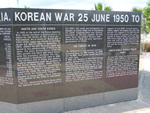
In 1905 at the end of the
Russo-Japanese War,
Korea became a protectorate of
Japan by the terms of the
Treaty of Portsmouth. As a result of
World War II (1941-1945) Japan was forced to surrender to
the U.S. and its’ allies on September 15, 1945 aboard the USS Missouri.
Japan was forced to turn administration of Korea to the allies. The allies divided
Korea along the
38th parallel into
North Korea and
South Korea with the boundary between the two designated a demilitarized
zone or DMZ.
The northern half of Korea was administered by communists under the guidance of
the
Soviet Union (USSR). Under Soviet guidance the North Koreans established
a North Korean People’s Congress. On August 25, 1948, the congress declared North
Korea the Democratic People’s Republic of Korea (DPRK). Kim Il Sung was made premier
of the DPRK on September 9, 1950.
The U.S. administered South Korea after the Japanese turned the territory over to
the allies. The south was designated the Republic of Korea (ROK) and on September
15, 1948.
Syngman Rhee was elected president of the new republic. On that same date
the ROK the only legitimate government of Korea.
The Threat of War
By 1949 military and political conflicts escalated along the DMZ between the DPRK
and the ROK. Small battles caused casualties on both sides.
In 1950, U.S. Secretary of State
Dean Acheson publicly declared Korea excluded from the U.S. Far East defense
perimeter. North Korea interpreted this as an indication that the U.S. would not
defend South Korea against an attack. At this time the U.S. had less than 482 military
advisors in South Korea.
Although both countries withdrew troops from Korea, the Soviets in 1948 and the
U.S. in 1949, both sides kept advisors in the two Koreas. Soviet and Communist Chinese
support of the DPRK included money, military supplies and weapons like tanks and
aircraft. U.S. support of the ROK did not include powerful weapons like tanks, aircraft
or heavy artillery out of fear that ROK forces might use this equipment to start
war with the DPRK and cause a major international conflict between the U.S. and
the Soviet Union or Communist China.
North Korea Invades South Korea
On June 25, 1950, the North Korean People’s Army (NKPA) of approximately 150,000
men attacked across the DMZ into the ROK with 7 Infantry Divisions, 150 Russian
made T-34 tanks, heavy artillery and combat aircraft. The ROK forces consisted of
8 poorly supplied Infantry Divisions lacking air, tank or heavy artillery support.
In reaction to the attack, the
United Nations (UN) passed a resolution within hours of the attack calling on the DPRK to cease fire and withdraw their troops.
On June 27, 1950, U.S.
President Harry S. Truman ordered General of the Army (five stars) Douglas
MacArthur, Supreme Commander of Allied Forces (SCAP) and U.S. Commander-in-Chief
of Ground Forces in the Far East (CINCFE), to support ROK resistance with available
U.S. air and naval forces and to provide military supplies to the ROK.
By June 27, the NKPA 1st, 3rd, 4th and 5th
Infantry Divisions had penetrated the poorly equipped 1st, 6th,
7th, 9th ROK Infantry Divisions and the 17th ROK
Brigade, and occupied
Seoul, the capital of South Korea. As a result of these attacks, the ROK
forces suffered approximately 34,000 casualties in just three days. The NKPA forces
continued their drive to occupy all of South Korea.
Wall 2: American Combat Forces Enter the War
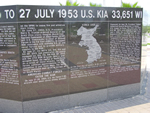
On June 27-28, 1950,
U.S. Air Force F-80 aircraft shot down seven enemy aircraft on the first
day of combat.
B-26 and
B-29 aircraft strafed and bombed enemy positions.
On June 29, 1950, the
USS Juneau shelled NKPA targets. The UN placed all national forces operating
in Korea under U.S. Command. On June 30, President Truman authorized General MacArthur
to deploy U.S. troops to Korea. The 24th and 25th U.S. Infantry
Divisions were ordered to Korea. On July 1, 1950, the 1st Battalion,
21st Regiment, 24th Infantry Division composed of 440 soldiers
arrived in
Pusan by
C-124 “Globemaster” aircraft. The battalion became Task Force Smith
and was moved directly to
Osan on the Seoul-Pusan highway as a blocking force to delay the NKPA.
Only July 3, 1950,
Inchon fell to the NKPA. On July 5th, the heavy NKPA 4th
Infantry Division supported by tanks, broke through Task Force Smith’s position
causing 152 U.S. casualties.
The NKPA then broke through the next delaying position at Pyongtaek held by units of
the U.S. 24th Infantry Division. Chonan, the third U.S. delaying position,
was overrun even though U.S. forces fought valiantly. Approximately 66% of U.S.
troops were killed or captured in these battles.
U.S. and ROK troops fought desperately to delay the enemy and build defenses around
the port city of Pusan. These delaying actions were costly in lives on both sides. While this combat continued,
57
U.S. Army nurses arrived in Pusan to staff hospitals. By the end of the
war, 540 U.S. Army nurses had served in Korea during the conflict.
On July 7th, 1950, UN forces were placed under the command of General
Douglas MacArthur. U.S. and UN forces became united under the United Nations Command
(UNC).
On July 13, 1950, 8th U.S. Army Headquarters was established in Taegu
with
Lieutenant General Walton H. Walker in command. From July 10-18, the 25th
Infantry Division arrived in Pusan from Japan. Also on July 18, elements of the
1st Cavalry Division landed unopposed on Korea’s east coast near Pohang. To
protect the 1st Cavalry Division landings, the 24th Infantry
Division distracted NKPA forces by attacking at Taejon on July 19-20. During this
battle,
Major General William F. Dean, commanding general of the 24th
Infantry Division, personally destroyed an enemy tank with a hand grenade. He was
captured on August 26, 1950. His combat actions merited his award of the Medal of Honor.
He was the highest ranked U.S.
Prisoner of War during this conflict.
Wall 3: Pusan Perimeter

By August 4, 1950, U.S./UN forces had established a defensive line south and east
of the
Naktong River known as the “Pusan
Perimeter”. U.S. forces consisted of the 24th, 25th
and 2nd Infantry Divisions, the 1st Cavalry Division and the
1st Marine Brigade. Republic of Korea forces defending the perimeter
included the 1st, 3rd, 6th, 8th and
Capital Infantry Divisions.
By August 6, fierce fighting began around the “Naktong Bulge” where the 2nd
and 24th U.S. Infantry Divisions repelled enemy attacks. The Battle for
“Naktong Bulge” continued until August 8th when the 4th Infantry
Division of the NKPA withdrew north of the Naktong River after suffering heavy casualties.
By the end of August, other NKPA forces attacked across the river further south
but were stopped and the front lines became stable. It was estimated that the NKPA
lost half of their strength and 80% of their artillery and armor while U.S./UN reinforcements
caused forces to grown in strength despite heavy losses. U.S. casualties alone in
the defense of the “Pusan Perimeter” were estimated at over 5,000 men.
The Landing at Inchon
Holding the enemy at the Naktong River, General Douglas MacArthur planned a daring
attack to regain the lost territory. He planned a frontal assault on the enemy along
the Naktong while landing other American forces behind enemy lines to trap the NKPA
between the two U.S./UN forces. He chose Inch’on, 15 miles from Seoul, as the landing
site. The landing forces would have only 3-4 hours when the tide was high enough
to land men and supplies.
At 6.33 A.M. on September 15, the first landings were led by the 5th
Brigade, 1st U.S. Marine Division supported by 230 U.S./UN Naval ships.
The Americans encountered little resistance as the NKPA considered an attack at Inch’on unlikely because of the difficulty of a high tide landing. Most of the NKPA
forces were concentrated along the “Pusan Perimeter”. The 336 NKPA defenders at
Woimi-do, an island fort protecting Inch’on Harbor, were killed or captured. The
American landing force took the sea wall at high tide and by midnight most of the
city was in U.S. hands.
The next day, the 7th U.S. Infantry Division in Inch’on followed on this
victory by taking the high ground overlooking the main highway to Seoul, blocking
any NKPA reinforcements to the “Pusan Perimeter” coming from Seoul. By September
18, the Marines had captured Kimpo Air Field outside of Inch’on. On September 20,
the Marines and the 7th Infantry Division crossed the Han River
toward Seoul. Within two days they had retaken Yongdonp’o and were preparing a final
assault to retake Seoul. Many consider the Inch’on landing a brilliant military
maneuver.
Wall 4: Pusan Perimeter Breakout
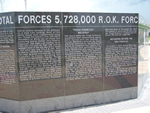
United Nations Command (UNC) forces within the “Pusan Perimeter” coordinated their
counterattack against NKPA forces with the landings at Inch’on. General MacArthur
believed then enemy would be confused by the landing and forced to organize their
troops. U.S./UN forces now outnumbered the NKPA forces 140,000 against 70,000. On
September 16th, the 5th U.S. Regimental Combat Team spearheaded
an advance from the perimeter with its armor near the city of Waegwan. They captured
Waegwan on September 19 and U.S. forces began moving across the Naktong River. On
September 30th, the U.S. 25th Infantry Division took Kunsan
while elements of the 1st Cavalry Division linked up with the 7th
Infantry Division moving from Inch’on to Osan. This concluded the “Pusan Perimeter”
breakout. By September 29, UNC forces had eliminated most of the NKPA forces south
of the 38th parallel, capturing 23,000 NKPA troops. UNC forces liberated
Seoul on September 29, 1950. The landings at Inch’on and the drive from the “Pusan
Perimeter” to Seoul cost U.S. forces 884 men killed in action and 3,868 men wounded
in action.
Advancing Beyond the 38th Parallel
On October 1, 1950, General MacArthur demanded North Korea’s surrender. The People’s
Republic of China (PRC) announced it would “not tolerate an invasion across the
38th Parallel.” That same day the 3rd and Capital Infantry
Divisions of the Republic of Korea (ROK) crossed the 38th Parallel. On
October 2nd, the invasion of North Korea became official under MacArthur’s
“United Nations Command Order 2”. That same day, U.S. forces discovered the bodies
of over 1,000 ROK and 30 American POWs killed by NKPA while under captivity near
the city of Taejon.
On October 7th, the 1st Cavalry Division moved north of the
38th Parallel supported by the 24th Infantry Division and
the ROK 1st Infantry Division. As a result of this invasion, the leader
of the PRC, Mao Zedong, decided to aid North Korea. At the same time the UN voted to
reunify Korea under the South Korean leadership.
By October 10, 1950, the ROK 3rd Infantry and Capital Divisions reached
110 miles into North Korea to Wonsan. On October 15th, the U.S. 1st
Cavalry Division surrounded the NKPA 27th and 29th Infantry
Divisions at Kumch’on. In a two day battle, the 1st Cavalry Division
killed over 500 NKPA troops. By the middle of October most NKPA units had retreated.
In their retreat, NKPA forces massacred large numbers of ROK and US POWs including
68 Americans killed in the “Twin Tunnels Massacre” on October 19th.
Wall 5: The Capture of Pyongyang
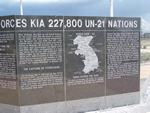
On October 20, 1950, 4,100 men of the 187th Airborne Regiment parachuted
into Sinch’on to cut off retreating North Koreans and were reinforced the next day
by another 1,800 men from the same unit. By October 27th, U.S. forces
occupied Pyongyang and the battle was over.
China Enters the War
As early as October 20, 1950, the Chinese People’s Volunteer Army (CPVA) of 150,000
men in the 13th Army Group had infiltrated across the Yalu River
to help the NKPA. Three of these armies moved toward Pyongyang to regain the capital.
Chinese plans called for another two armies to be in North Korea by the end of October.
Meanwhile, UNC forces continued moving north. By October 25th, ROK forces
were within 18 miles of the Yalu River and reported capturing Chinese soldiers.
On October 26th, the Chinese counter-offensive began at Onjong and Unsan,
forcing UNC troops in the are to withdraw. That same day the 1st Marine
Division landed at Wonsan and the 7th Infantry Division reached its farthest
northern advance at Hysansin on the Yalu River.
On October 27th, a combined force of 40,000 Chinese and NKPA drove back
the ROK 6th, 7th and 8th Infantry Divisions cutting
off a regiment of the U.S. 1st Cavalry Division. On October 31st,
the 1st Marine Division moved to the Chosin Reservoir to relieve the
ROK forces, which had suffered heavy casualties while retreating.
Wall 6: The Battles of Chosin Reservoir and Unsan
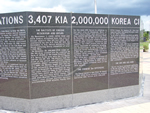
By November 1, 1950, CPVA 50th and 60th Armies attacked near
the city of
Unsan against the U.S. 1st Cavalry Division reinforced by the
U.S. 2nd Infantry Division. By November 4th, U.S. forces withdrew
from Unsan suffering heavy casualties of over 1,200 men.
On November 28th, 200,000 CPVA troops of the 9th Army crashed
into the combined UN force of 20,000 at the
Chosin Resovoir. The U.S. forces in the area were the 1st Marine
Division and the 7th Infantry Division. The Marines took the brunt of
the attack and suffered severe casualties. Almost surrounded and facing 10 to 1
odds, the Marines fought their way out of the surrounding CPVA forces and moved
south to
Hungnam for evacuation by sea. The route required them to fight through
enemy lines, march over 50 miles of hostile terrain, and face early winter storms.
The 500 man Marine “Task
Force Faith” fought rear action battles against overwhelming CPVA attacks,
buying time for the main UNC forces to withdraw to the port city of Hungnam. Most
of the “Task Force Faith” was sacrificed as they valiantly held back the attacking
CPVA. By December 13th the UNC forces arrived at Hungnam. The evacuation
withdrew 105,000 men, 91,000 refugees, equipment and supplies. The CPVA attacks
cost the UNC forces thousands of casualties including the destruction of the Turkish
Brigade. American forces suffered over 2,500 KIA, 5,000 WIA and another 3,500 injured
by frostbite. CPVA casualties were estimated between 40,000 – 70,000 men.
The CPVA units continued to advance all along the front, retaking Pyongyang on December
4th. By December 8, 1950, the U.S. 8th Army forces withdrew
south of the 38th Parallel.
The Chinese 3rd Offensive
The Chinese moved to take Seoul. On January 1, 1951, CPVA forces attacked the seriously
battered UNC forces with 500,000 CPVA troops. By January 15th, they had
captured Seoul and moved 50 miles south of the 38th Parallel.
In an effort to distract the CPVA and NKPA, UNC forces blockaded Wonsan Harbor with
naval “Task Force 95”. The blockade lasted over 860 days making it the longest U.S.
naval siege in history.
On March 8, 1951, UNC forces conducted “Operation
Ripper” to retake Seoul and move the enemy north of the 38th
Parallel. The U.S. 1st Cavalry Division, 1st Marine Division,
2nd, 3rd, 7th, 24th and 25th
Infantry Divisions took part in this attack and successfully captured Seoul, moving
on to the 38th Parallel by April 4th. On April 21, 1951, General
MacArthur was replaced by
General Matthew Ridgway as U.S. and UNC commander.
The Air and Sea War
The U.S. Air Force contributed significantly to the war effort. Most of the combat
units came from the 5th Air Force with support from the 13th
and 20th Air Force. They conducted extensive bombing missions and participated in “dog
fights” with enemy jet fighters. U.S. pilots shot down 895 of the 935 enemy
aircraft destroyed during the war. The Air Force had 39 aces (pilots who shot down
5 or more aircraft).
Joseph McConnell destroyed 16. On August 29, 1952, allied air units in Korea
launched a single raid of 1,403 sorties in an attack on Pyongyang in the largest
air raid of the war.
The Marines had their own air unit, the Marine Aircraft Group 33 (MAG 33). Some
of these aircraft were based aboard the
USS Sicily and the
USS Badoeng Straight while other aircraft were ground based. The U.S.
Navy also supplied aircraft from Carrier Air Group 11. At one point or another,
36 aircraft carriers participated in the Korean War.
The navy’s warships also provided much needed support for a number of seaborne operations.
Along with the carriers, 4 battleships, 13 cruisers and over 100 destroyers as well
as many smaller combat and support ships, participated in the war. Of these, 5 were
sunk in combat, including the
USS Pirate and
USS Pledge on October 12, 1950. The
U.S. Coast Guard provided non-combat missions including port security
and search and rescue.
Wall 7: The War Drags On

In April and May of 1951, CPVA forces and NKPA troops conducted two offensives to
recapture Seoul using 200,000 troops. UNC defenses provided by U.S. 7th,
24th and 25th Infantry Divisions along with the 1st
Marine Division with air support defeated these attacks. Eventually the war turned
into a scramble for hills along the battlefront near the 38th Parallel.
Battles for Hill 938 and
Heartbreak Ridge turned into stalemates with high casualties. On September
21, 1951, the U.S. used helicopters for the first time to deploy 228 Marines in
battle.
Peace Talks Begin
The UNC, North Korea and China opened peace talks on July 10, 1951. Both sides were
cautious and tried to gain advantages on the battlefield that might influence the
final results of the talks. The two sides met at Panmunjom and by November
27, 1951, both sides agreed on a demilitarized zone near the 38th Parallel.
Significant differences, including the return of POWs, continued to slow down the
talks.
The Battles for the Hills
By December 28, 1951, the 45th Infantry Division arrived in South Korea
to relieve the 1st Cavalry Division. In June and July the 45th
Infantry Division found itself locked in combat around “Old Baldy” (Hill
266). The battle centered around the control of hills near the 38th Parallel.
From August 12-16, the 1st Marines found for control of Bunker Hill (Hill
122). The 7th Infantry Division fought the battle for Sniper Hill (Hill
598) from October 14-25. The 40th Infantry Division arrived in South
Korea on February 3, 1952, to replace the 24th Infantry Division and
found itself fighting to defend
Heartbreak Ridge (Hill 851) on November 3, 1952.
One famous battle was the
Battle of Pork Chop Hill from April 16-18, 1953. Enemy forces made a series
of strong attacks on the 7th Infantry Division. After taking serious
casualties and killing many enemy troops, the 7th Infantry Division forced
the enemy to withdraw. From July 6-10, 1953, the enemy renewed their attack on Pork
Chop Hill, eventually forcing the withdrawal of the 7th Infantry Division.
Wall 8: The Armistice
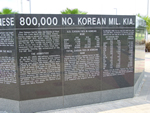
On July 27, 1953, the military commanders of the UNC, China and North Korea signed
the “Joint
Policy Statement” to end the fighting and return the Prisoners Of War (POW).
There were 7,246 U.S. POWs taken during the war, 2,806 of whom died while in captivity.
The high death rate of POWs can be attributed to the poor treatment they received
in the camps. The armistice did not create a formal peace between the two Koreas
which have maintained a hostile relationship to this year of 2005. The combatants
agreed to a demilitarized zone along the battle front near the 38th Parallel.
U.S. Casualties in the Korean War
| |
KIA |
WIA |
MIA |
| Army |
27,709 |
77,596 |
4,578 |
| Air Force |
1,198 |
368 |
991 |
| Navy |
475 |
173 |
103 |
| Marines |
4,269 |
23,744 |
386 |
| Total |
33,651 |
101,881 |
6,058 |
Total Casualties in the Korean War
Twenty-one nations supplied forces to help South Korea through the UN Council under
U.S. Command. Of these, Denmark, India, Italy, Norway and Sweden sent non-combat
medical staff. The remaining countries included Australia, Belgium, Canada, Colombia,
Ethiopia, France, Greece, Italy, Luxembourg, the Netherlands, New Zealand, the Philippines,
South Africa, Thailand, Turkey, the United Kingdom and the United States. Of these
the U.S. supplied the largest force of 5,728,000. Republic of Korea forces had 227,800
killed in action and 717,100 wounded in action. Estimates of Korean civilians killed
in the war may be as high as 2,000,000.
UN Casualties Korean War
| |
KIA |
WIA |
Total Forces |
| Australia |
339 |
1,216 |
17,164 |
| Belgium |
101 |
335 |
3,498 |
| Canada |
312 |
1,212 |
26,794 |
| Colombia |
163 |
448 |
6,200 |
| Ethiopia |
121 |
536 |
3,518 |
| France |
262 |
1,008 |
4,000 |
| Greece |
192 |
543 |
5,000 |
| Luxembourg |
2 |
13 |
89 |
| Netherlands |
120 |
645 |
5,300 |
| New Zealand |
23 |
79 |
4,500 |
| Philippines |
122 |
299 |
7,500 |
| South Africa |
34 |
16 |
811 |
| Thailand |
129 |
1,139 |
6,500 |
| Turkey |
741 |
2,068 |
15,000 |
| United Kingdom |
746 |
2,533 |
60,000 |
There are no exact figures for North Korean or Chinese casualties but U.S. estimates
place 900,000 CPVA casualties and 800,000 NKPA casualties.